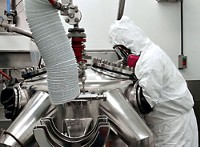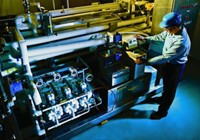Advertisement
Grab your lab coat. Let's get started
Welcome!
Welcome!
Create an account below to get 6 C&EN articles per month, receive newsletters and more - all free.
It seems this is your first time logging in online. Please enter the following information to continue.
As an ACS member you automatically get access to this site. All we need is few more details to create your reading experience.
Not you? Sign in with a different account.
Not you? Sign in with a different account.
ERROR 1
ERROR 1
ERROR 2
ERROR 2
ERROR 2
ERROR 2
ERROR 2
Password and Confirm password must match.
If you have an ACS member number, please enter it here so we can link this account to your membership. (optional)
ERROR 2
ACS values your privacy. By submitting your information, you are gaining access to C&EN and subscribing to our weekly newsletter. We use the information you provide to make your reading experience better, and we will never sell your data to third party members.
Business
Private Equity Ponies Up Again In Custom Chemicals
Cambridge Major, ChemDesign, and VanDeMark, change hands at the close of 2012
by Rick Mullin
February 11, 2013
| A version of this story appeared in
Volume 91, Issue 6

When private equity firms began investing in the U.S. custom chemical sector toward the end of 2006, industry watchers wondered whether to take buyers at their word regarding a commitment to stick with and grow their acquired companies. Many figured that the new owners would do what private equity is often criticized for: slash costs for a short-term profit jump and then sell out at the earliest opportunity.
The flurry of deals at the end of 2012 indicates that the skeptics were correct about one thing: Private equity is working on something like a five-year ownership cycle. But their handling of the businesses might surprise some critics. In the case of three custom chemical firms—VanDeMark Chemical, ChemDesign, and Cambridge Major Laboratories—the temporary owners can point to lasting operational improvements.
Buckingham Capital Partners, which sold VanDeMark to Uni-World Capital and Brightwood Capital Advisors, takes credit for a significant turnaround at the Lockport, N.Y., company, which is the only producer of phosgene (COCl2) in North America. Phosgene is a major industrial chemical that is also a poisonous gas.
Prior to its sale to Buckingham, VanDeMark had been owned for five years by SNPE, a French conglomerate that was a major European producer of phosgene. State-owned SNPE established VanDeMark as its main U.S. operation and integrated it with Paris-based sales and marketing efforts. But shortly afterward, SNPE decided to exit the chemicals business. When Buckingham purchased VanDeMark, the firm no longer had a dedicated sales staff, according to Albert Naggar, managing partner at Buckingham.
“The French government had essentially made VanDeMark a production facility,” Naggar says. The company performed poorly for the first year after Buckingham acquired it, nearly failing to make payroll at one point in 2009 as Naggar worked to restaff. “But by that summer we had the wind at our back,” he recalls. Under Buckingham, he says, the company eventually achieved profit margins approaching 30%.
Naggar describes selling the business as a natural and necessary course of action. “I have a private equity fund, so there is a time limit on how long I can hold my investments,” he says.
VanDeMark’s chief executive officer, Michael Kucharski, has been with the firm since it was family owned prior to its acquisition by SNPE. “Suffice it to say, we made some great progress after being carved out from SNPE and set up on our own again to make our own decisions,” Kucharski says. “We grew the company and can better use our financing now to continue to grow.”
Christopher P. Fuller, managing partner at Uni-World, which purchased VanDeMark for an undisclosed amount with financial support from Brightwood, says his firm is primarily interested in investing in growing companies. VanDeMark is Uni-World’s first chemical asset, and Fuller says he likes its growth prospects.
“We look for companies with a good strategic position and management team. VanDeMark,” he says, “has both.” The company has done a good job leveraging its solo position in phosgene, he argues, and growth will likely accelerate as low energy costs in the U.S. bring custom manufacturing back from overseas. Uni-World is prepared to invest in VanDeMark, Fuller adds, and will be on the lookout for acquisitions.
Private equity firm Resilience Capital Partners also handed its custom chemical asset over to another financial buyer, Lubar & Co., in better shape than when it was acquired. ChemDesign, a family-owned firm in Marinette, Wis., had gone into bankruptcy in 2006, according to Vice President of Sales & Marketing Rae Johnson, making it an attractive property for Resilience.
“Their niche in the private equity world is turning around companies in special situations,” Johnson says. Resilience made an additional investment in the company in 2007 to improve its capital structure, he explains.
The firm has reduced its reliance on manufacturing chemicals for thermal paper and now does 60% of its work in agricultural chemicals and only 10% in thermal paper. Lubar aims to double the company’s annual sales, which are between $20 million and $30 million, over the next five years.
“Their strategy is to be a long-term holder,” Johnson says, noting that Lubar is a family-run business that invests mostly in companies in the Midwest. “Growing the company is going to require expansion on the Marinette site as well as bolt-on acquisitions at some point.”
Although ChemDesign is Lubar’s first investment in custom chemicals, Vince Shiely, a partner at the firm, says it fits squarely with Lubar’s investment profile. “We aren’t looking for chemical companies,” he says. “We’re always looking for growth opportunities.” And Shiely sees custom manufacturing as a market primed for growth in the U.S.
Milestones For Three Custom Chemical Firms
Private Equity Transactions
Cambridge Major Laboratories
◾ Founded in 1998 by Michael Major
◾ Purchased in 2007 by Arlington Capital Partners
◾ Purchased in December 2012 by American Capital Partners
ChemDesign
◾ Founded in 1982 by Richard E. T. Brooks
◾ Purchased in 2006 by Resilience Capital Partners
◾ Purchased in November 2012 by Lubar & Co.
VanDeMark Chemical
◾ Founded in 1951 by Allan VanDeMark Sr.
◾ Purchased in 2003 by SNPE
◾ Purchased in 2007 by Buckingham Capital Partners
◾ Purchased in December 2012 by Uni-World Capital and Brightwood Capital Advisors
“Some of our due diligence would suggest that large chemical companies want to put their development efforts into things like R&D and into their larger manufacturing operations,” Shiely says. “Working on smaller volume, high-complexity molecules and chemical compounds is not where they want to invest their capital.”
As for investment in expanded operations or acquisitions, “that’s to be determined,” Shiely says. “ChemDesign has a lot of opportunities with their existing customers, and those are obviously your first target. I always say, ‘Find out who your friends are, and sell more to them.’ We are not looking to be on a buying spree.”
A custom manufacturer of active pharmaceutical ingredients (APIs), Cambridge Major was in no need of a turnaround when it was acquired by Arlington Capital Partners in early 2007. The firm, however, had some ambitious growth objectives, which were supported by its new owner. Arlington invested $40 million in a new, large-scale manufacturing facility at Cambridge Major’s headquarters in Germantown, Wis., and funded the acquisition of ChemShop, an API maker in Weert, the Netherlands.
The investments seemed to pay off for Arlington. Last December, the private equity firm sold Cambridge Major to another private investor, American Capital Partners, which committed $212 million.
Private equity is getting a lot more active in the pharmaceutical chemicals sector, according to Brian Scanlan, Cambridge Major’s CEO. “Many investors are bullish on the pharma services space, with the rationalization of big pharma assets and personnel,” he says. “They see an opportunity longer term to leverage contract assets.”
And Scanlan sees American Capital as a long-term investor. “They are quite a large firm with a lot of internal resources, including operating partners who are former chief operating officers from companies that have lean operations and operational excellence experience. You don’t see that in a lot of the boutique private equity firms.”
American Capital also has experience in pharmaceutical chemicals. Kyle Bradford, a partner, points to Scientific Protein Labs, a company in his firm’s portfolio that purifies natural pharmaceuticals including heparin.
The increased activity by private equity investors is largely a response to a coming upturn in the custom manufacturing market, Bradford posits. Drug development projects that had been cut during the recession are likely to come back in the months ahead. “I think we could be at the early stage of another cycle,” he says.
Growth is also expected in nonpharmaceutical custom manufacturing, which has some industry watchers wondering why, amid all the private equity activity, more chemical companies aren’t looking to buy. But the deals late last year did include one such transaction, the acquisition of Pittsburgh-based Pressure Chemical by Minafin, a French chemical company that has made several North American acquisitions in recent years.
Frédéric Gauchet, CEO of Minafin, says his firm’s latest deal broadens its technology offering with Pressure’s high-pressure chemistry, metal catalysis, and other specialties. And the timing was right, because Pressure’s majority owner, Larry Rosen, was looking to sell the company. Rosen, whose father was one of the partners who founded Pressure in 1964, had hired John Pannucci, a former Rhodia executive, as CEO to assist with the transition.
“At the same time, Pressure Chemical had an active program looking to expand beyond the footprint we had in Pittsburgh,” Pannucci says. “We were kind of landlocked and had been looking at acquiring a second site. Then Minafin approached us, and it seemed like a good fit.” Instead of acquiring a new site, says Pannucci, Pressure will use Minafin manufacturing assets to scale up products made in Pittsburgh.
Pressure received a steady stream of inquiries from private equity firms, Pannucci says. But although such buyers often come with cash to invest, they also need to produce a short-term return on their investment, which would have complicated efforts to buy a new site. “What was more important to us when we viewed Minafin,” he says, “was that they have a strategic interest in chemicals and other facilities.”
Pannucci agrees that the flurry of activity among financial buyers at the end of last year marks a trend that will likely continue. And the trend makes sense, according to James R. Bruno, president of the consulting firm Chemical & Pharmaceutical Solutions.
“A bunch of these guys are basically saying, ‘It’s up, let’s sell.’ ” And it’s no surprise that a lot of the sales are happening in the U.S., Bruno says. Custom manufacturing is on the rise stateside partly because more U.S. than European chemical and pharmaceutical firms scaled back manufacturing during the recession.
“Life is good now,” Bruno says. “I hope we all remember things were not so good a while back and not make the mistakes we made before. I just hope these buyers will have the wherewithal to stay with it long enough and not get tired and cut deals that are not in the industry’s interest. I hope they realize they need to make some further investments to do it well and correctly.”








Join the conversation
Contact the reporter
Submit a Letter to the Editor for publication
Engage with us on Twitter